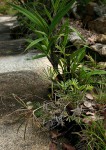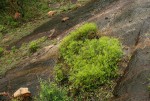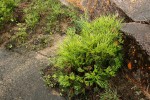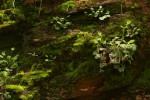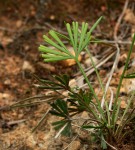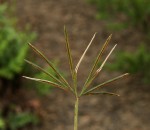Actiniopteris dimorpha Pic.Serm. ssp. dimorpha
Synonyms |
|
|---|---|
Common name |
|
Description |
Rhizome shortly creeping, c. 5 mm in diameter; rhizome scales linear, of two types: concolorous pale brown, wholly membranous ones and discolous ones with a central dark stripe and light membranous margins. Stipe 3-4 times as long as lamina, pale brown to strawcoloured, with few scales at the base, otherwise glabrous. Fronds densely tufted, erect, distinctly dimorphic, differing both in size and stipe length as well as in shape and degree of lamina dissection. Lamina flabellate, dried lamina bent over sharply at an angle of 90° or more with the stipe. Sterile frond 3-15 cm long, repeatedly dichotomously divided into 11-36 (linear segments, segments apices serrate with 3-6 teeth. Fertile frond 5-29 cm long, pseudo-palmate, dividing dichotomously into 7-26 linear segments, segment ending in a point, or a notch and 2 small points. Sori in submarginal lines, partly obscured by reflexed margin; indusium continuous, membranous. |
Notes | Can be confused with Actiniopteris radiata. A. radiata is weakly dimorph, fertile and sterile fronds differing in size and stipe length, but not significantly in shape or degree of lamina dissection. A. radiata also has about twice the number of segments on the fertile frond. |
Derivation | dimorpha: two forms; refers to the difference in the sizes of the sterile and fertile fronds. |
Habitat | On granite outcrops, common on sheetrock, growing on islands of overlaying soil and vegetation, or sometimes at the base of boulders. |
Distribution worldwide | |
Distribution in Africa |
Botswana, Burundi, Congo, Dem. Republic of Congo, Ethiopia, Kenya, Malawi, Mozambique, Somalia, South Africa, Sudan and South Sudan, Tanzania , Uganda, Zambia, Zimbabwe. |
Growth form |
Lithophytic, terrestrial. |
Literature |
|
